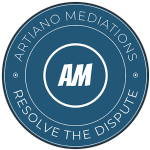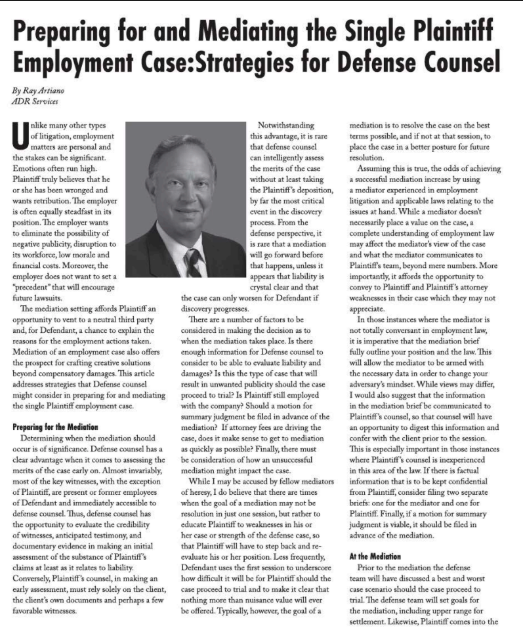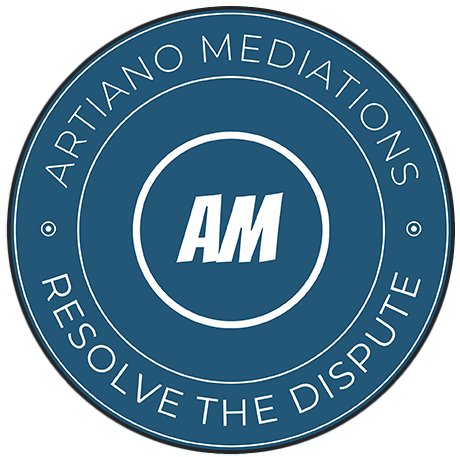Preparing for and Mediating the Single Plaintiff Employment Case
Strategies for Defense Counsel
2025
Unlike many other types of litigation, employment matters are personal and the stakes can be significant. Emotions often run high. Plaintiff truly believes that he or she has been wronged and wants retribution. The employer is often equally steadfast in its position. The employer wants to eliminate the possibility of negative publicity, disruption to its workforce, low morale and financial costs. Moreover, the employer does not want to set a “precedent” that will encourage future lawsuits.
The mediation setting affords Plaintiff an opportunity to vent to a neutral third party and, for Defendant, a chance to explain the reasons for the employment actions taken. Mediation of an employment case a also offers the prospect for crafting creative solutions beyond compensatory damages. This article addresses strategies that Defense counsel might consider in preparing for and mediating the single Plaintiff employment case.
Preparing for the Mediation
Determining when the mediation should occur is of significance. Defense counsel has a clear advantage when it comes to assessing the merits of the case early on. Almost invariably, most of the key witnesses, with the exception of Plaintiff, are present or former employees of Defendant and immediately accessible to defense counsel. Thus, defense counsel has the opportunity to evaluate the credibility of witnesses, anticipated testimony, and documentary evidence in making an initial assessment of the substance of Plaintiff’s claims at least as it relates to liability. Conversely, Plaintiff’s counsel, in making an early assessment, must rely solely on the client, the client’s own documents and perhaps a few favorable witnesses.
Notwithstanding this advantage, it is rare that defense counsel can intelligently assess the merits of the case without at least taking the Plaintiff’s deposition, by far the most critical event in the discovery process. From the defense perspective, it is rare that a mediation will go forward before that happens, unless it appears that liability is crystal clear and that the case can only worsen for Defendant if discovery progresses.
There are a number of factors to be considered in making the decision as to when the mediation takes place. Is there enough information for Defense counsel to consider to be able to evaluate liability and damages? Is this the type of case that will result in unwanted publicity should the case proceed to trial? Is Plaintiff still employed with the company? Should a motion for summary judgment be filed in advance of the mediation? If attorney fees are driving the case, does it make sense to get to mediation as quickly as possible? Finally, there must be consideration of how an unsuccessful mediation might impact the case.
While I may be accused by fellow mediators of heresy, I do believe that there are times when the goal of a mediation may not be resolution in just one session, but rather to educate Plaintiff to weaknesses in his or her case or strength of the defense case, so that Plaintiff will have to step back and reevaluate his or her position. Less frequently, Defendant uses the first session to underscore how difficult it will be for Plaintiff should the case proceed to trial and to make it clear that nothing more than nuisance value will ever be offered. Typically, however, the goal of a mediation is to resolve the case on the best terms possible, and if not at that session, to place the case in a better posture for future resolution.
Assuming this is true, the odds of achieving a successful mediation increase by using a mediator experienced in employment litigation and applicable laws relating to the issues at hand.While a mediator doesn’t necessarily place a value on the case, а complete understanding of employment law may affect the mediator’s view of the case and what the mediator communicates to Plaintiff’s team, beyond mere numbers. More importantly, it affords the opportunity to convey to Plaintiff and Plaintiff’s attorney weaknesses in their case which they may not appreciate.
In those instances where the mediator is not totally conversant in employment law, it is imperative that the mediation brief fully outline your position and the law. This will allow the mediator to be armed with the necessary data in order to change your adversary’s mindset. While views may differ, I would also suggest that the information in the mediation brief be communicated to Plaintiff’s counsel, so that counsel will have an opportunity to digest this information and confer with the client prior to the session. This is especially important in those instances where Plaintiff’s counsel is inexperienced in this area of the law. If there is factual information that is to be kept confidential from Plaintiff, consider filing two separate briefs: one for the mediator and one for Plaintiff. Finally, if a motion for summary judgment isviable, it should be filed in advance of the mediation.
At the Mediation
Prior to the mediation the defense team will have discussed a best and worst case scenario should the case proceed to trial.The defense team will set goals for the mediation, including upper range for settlement. Likewise, Plaintiff comes into the mediation with a goal and a bottom line. If it happens that the Plaintiff’s bottom line and Defendant’s upper range coincide, or are fairly close, the case will almost always settle. It is where there is a large gap between the two ranges that the work needs to be done.
Defendant has both monetary and non-monetary tools at its disposal. If Plaintiff is still an employee, it is particularly important to allow the opportunity to tell his or her story, and that Defendant’s representative listen. It is equally important that Defendant’s representative has a chance to explain the employment actions taken. Often, this is the first time Plaintiff has heard why Defendant did what they did, and may go a long way towards bridging a settlement gap. In doing this, it is important that the “conveyor” of the explanation is articulate,evinces sympathy for Plaintiff and Plaintiff’s position, and convincing as to the reasons for the actions taken.
The “conveyor “should be someone likely to be well received by Plaintiff. Sometimes all that is needed for an existing employee to agree to resolution is the explanation and minor job alterations. Non-monetary tools that can be utilized may include such things as letters of reference, the purging of files, job placement assistance, training for the employee or employer’s staff or changes in written policies.
With respect to monetary offers, the typical mediation involvesa series of demands and offers that hopefully results in an agreeable monetary settlement. Before the mediation, there may have been demands and or offers that have been made, thereby setting parameters. More often, the parties have not engaged in serious dialogue concerning settlement. As a Defendant, where should negotiations begin? It is often said that first offer should be “in the ballpark.”While this may be true in some situations, most Plaintiff’s lawyers expect a very low initial offer, and have told their clients that is what is to be expected. An initial offer which is in the ballpark may establish unrealistic expectations on the part of the Plaintiff and hinder settlement possibilities. Typically Plaintiff’s demand will not be in the ballpark either. So it is important that the initial offer be responsive to the Plaintiff’s demand and provide Defendant with ample room to maneuver. The caveat to this is that the offer must not be so low that it is insulting and causes Plaintiff to either leave the mediation or make an equally unreasonable counter.
Bridging the monetary settlement gap can be achieved in two ways: by changing Plaintiff’s view of the “bottom line” or by utilizing pressure points. Changing Plaintiff’s view of the bottom line involves the communication to Plaintiff’s team of legal or factual issues that are either unrecognized or under-appreciated by Plaintiff’s team. This may involve educating the Plaintiff’s attorney on the reasons to question the legal merits of one or more claims which could alter the view on liability or recoverable damages. For example, Defendant might educate Plaintiff’s counsel on the legal reasons as to why non-economic damages are unavailable, resulting in a reevaluation of the “bottom line.”
The revelation of factual issues of which Plaintiff may or may not be aware can also have a similar effect. For example, let’s suppose Defendant has information that Plaintiff misrepresented qualifications on an employment resume. Plaintiff may not have known that the Defendant was aware of this, but once this knowledge is communicated, Plaintiff may reevaluate the case value in the context of the likelihood of prevailing on liability,which may also lead to a downward movement in the bottom line. Finally, Defendant may change the bottom line view by challenging the specifics of Plaintiff’s demand. Does the Plaintiff’s demand place an unrealistic value on certain elements of economic or noneconomic damages? All too often the starting point of Plaintiff’s demand goes unchallenged and may have no bearing whatsoever on even the possibility of a “ring the bell” verdict. If this is the case, it should be addressed head-on in order to establish more reasonable settlement parameters.
Insofar as pressure points are concerned, the leverage which can be applied by Defendant is much more limited than that available to Plaintiff, but none the less valuable. Defendant must demonstrate the risks of failing to settle. One way to achieve that is by filing a motion for summary judgment prior to the mediation. Unless such a motion has no chance of success (in which case it should not have been filed), Plaintiff must contemplate that possibility, and weigh the effects of such an eventuality. In addition, often missed or uncommunicated to Plaintiff are the consequences of not accepting a reasonable offer. If a reasonable offer is turned into a statutory offer to compromise, and a lesser amount is achieved at trial, Plaintiff could become liable for certain costs even if successful. Finally, in cases where damages are relatively minor and attorney fees are driving the case, Plaintiff must be made to understand that a smaller amount in settlement at mediation may result in a greater net recovery, even if a larger jury verdict is rendered.
Conclusion
While there are certainly challenges that make the successful resolution of employment case more difficult than others, proper preparation, the use of monetary and non-monetary tools, and the utilization of bridging-the-gap strategies increase the chances of doing so.


